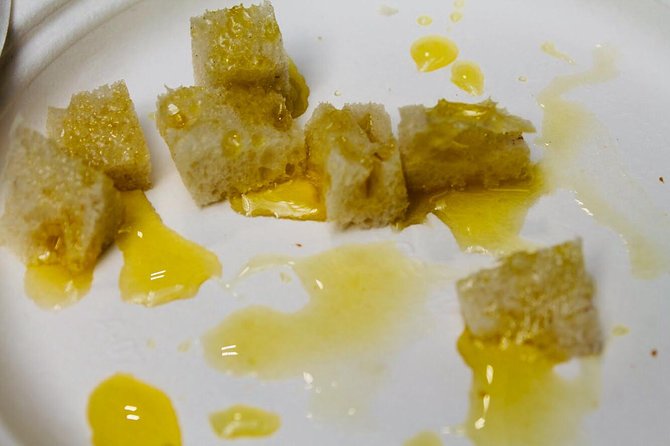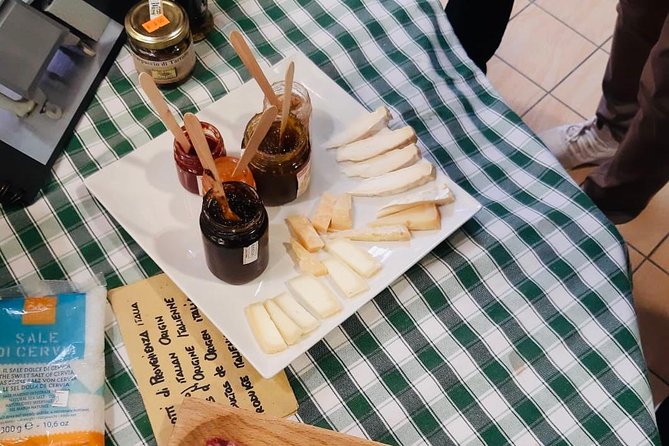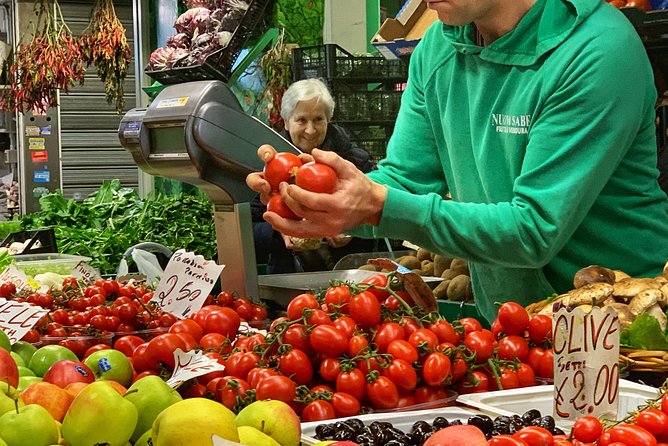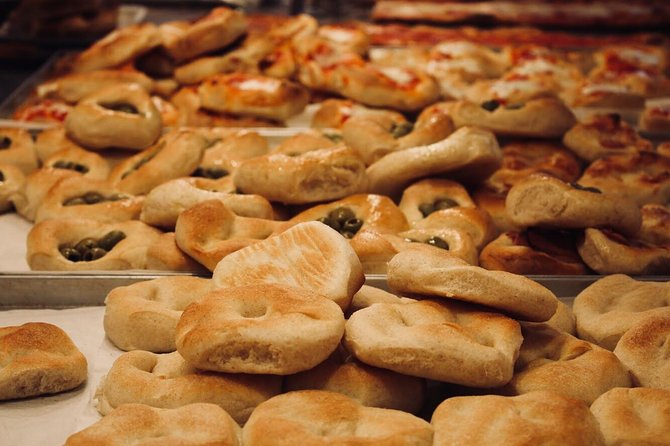Did you know that Rome is not only known for its rich history and stunning architecture, but also for its delectable culinary delights? With an abundance of authentic Italian dishes and local markets, Rome offers a food experience like no other.
If you’re a food lover looking to explore the traditional food, local market, and history of Rome, then ‘Eat Like a Roman’ is the perfect tour for you. With knowledgeable guides leading the way, this tour promises to take you on a gastronomic journey through the heart of Rome, allowing you to taste the flavors of ancient Rome and uncover the secrets of Roman street food.
But that’s not all – this tour also offers the opportunity to discover the influence of ancient Rome on modern Italian cuisine and indulge in a wine tasting experience like no other.
So why wait? Join ‘Eat Like a Roman’ and discover the culinary wonders that Rome has to offer.
This experience made our list of the 20 Best Historical Tours In Rome.
Good To Know

- Traditional Roman dishes include carbonara, cacio e pepe, amatriciana, saltimbocca alla Romana, and supplì.
- Trattoria da Cesare al Casaletto, Da Enzo al 29, Roscioli, and Pizzarium are popular eateries in Rome known for their authentic Roman cuisine.
- Campo de’ Fiori Market, Testaccio Market, Mercato di Campagna Amica, Mercato di Via Sannio, and Mercato Trionfale are local markets in Rome offering a variety of fresh produce and local products.
- Roman cuisine is characterized by simplicity, use of local ingredients, and the influence of ancient Roman recipes. It also includes Jewish culinary traditions from the Jewish Ghetto in Rome.
Roman Cuisine: A Journey Through History
Set out on a tantalizing culinary adventure as we take you on a journey through the rich history of Roman cuisine. Unearthing forgotten recipes and tracing culinary traditions, this points delves into the heart and soul of Roman gastronomy.
Roman cuisine is deeply rooted in ancient traditions and influenced by diverse cultures, resulting in a unique and flavorful culinary heritage. From the simplicity of Cacio e Pepe, a classic pasta dish made with pecorino cheese and black pepper, to the indulgence of Porchetta, a succulent roasted pork seasoned with aromatic herbs, each dish tells a story of centuries-old culinary practices.
Enjoying the local flavors? More Rome food experiences we've written about
Exploring Rome’s Local Markets

Hidden within the bustling streets of Rome lie vibrant local markets, waiting to be explored and savored by foodies from around the world. These traditional marketplaces offer a unique and authentic culinary experience, allowing visitors to enjoy the rich culinary traditions of Rome. From fresh produce to artisanal cheeses and cured meats, these markets are a treasure trove of local delights.
To help you navigate through Rome’s local markets, here is a handy table showcasing some of the must-visit markets and the specialties they offer:
| Market | Specialties |
|---|---|
| Campo de’ Fiori | Fresh fruits, vegetables, and spices |
| Mercato di Testaccio | Local cheeses, meats, and seafood |
| Mercato Trionfale | Wide variety of Italian delicacies |
| Mercato Esquilino | International ingredients and spices |
| Mercato Piazza Vittorio | Middle Eastern and Asian flavors |
Exploring these markets not only allows you to indulge in the authentic flavors of Rome, but also gives you a glimpse into the vibrant culinary culture that has been passed down through generations. So, don’t miss the opportunity to visit these markets and embark on a culinary adventure through the heart of Rome.
Traditional Roman Dishes You Must Try

When exploring the culinary delights of Rome, be sure to indulge in the traditional Roman dishes that are a true reflection of the city’s rich gastronomic heritage. Traditional Roman dishes have a long history that dates back to ancient times.
One iconic dish is the Roman-style pizza, known as ‘Pizza Romana.’ It’s characterized by its thin, crispy crust and simple toppings like tomato sauce, mozzarella cheese, and fresh basil.
Another must-try dish is ‘Cacio e Pepe,’ a classic pasta dish made with pecorino cheese and black pepper.
Plus, ‘Saltimbocca alla Romana’ is a delicious dish made with thin slices of veal, prosciutto, and sage, cooked in white wine and butter.
These dishes showcase the history of Roman cuisine and are sure to delight your taste buds.
Uncovering the Secrets of Roman Street Food

As we continue our culinary journey through Rome, let’s now uncover the tantalizing secrets of Roman street food. The street food culture in Rome is a vibrant and integral part of the city’s culinary scene.
Here are five hidden food gems that you must try:
Supplì: These deep-fried rice balls are filled with gooey mozzarella and ragù sauce. A perfect on-the-go snack.
Porchetta: Succulent roasted pork with crispy skin, seasoned with fragrant herbs and spices. Served in a crusty roll, it’s a true taste of Roman street food.
Pizza al Taglio: The Roman version of pizza, it’s sold by the slice and features a thick, rectangular crust topped with a variety of delicious ingredients.
Trapizzino: A fusion of pizza and sandwich, the trapizzino is a pocket of pizza dough filled with classic Roman dishes like cacio e pepe or braised oxtail.
Gelato: While not exclusive to Rome, the city boasts some of the best gelato in the world. Indulge in a cone or cup of creamy goodness from one of the many gelaterias scattered throughout the city.
These hidden food gems won’t only satisfy your taste buds but also give you a glimpse into the vibrant street food culture of Rome.
Wine Tasting and Pairing in Rome

Discover the rich flavors and artful pairings of Rome’s wine tasting scene, where a glass of vino becomes a sensory journey through the city’s storied vineyards and centuries-old traditions.
Wine tasting in Rome is a delightful experience that allows visitors to discover the diverse and exquisite wines of the region. From the robust reds of the Tuscan region to the crisp whites of the Lazio region, there’s a wine to suit every palate.
Rome’s wine bars and enotecas offer a wide selection of wines for tasting, allowing visitors to sample different varieties and learn about the unique characteristics of each wine. To enhance the tasting experience, experts are on hand to guide visitors through the various flavors and aromas, as well as offer recommendations for wine pairing with local dishes.
Whether you’re a wine connoisseur or simply curious to explore the world of Italian wines, wine tasting in Rome is an experience not to be missed.
More tours and activities we've covered in Rome
- Rome:Appian Way E-Bike Tour With Catacombs, Aqueducts & Food
- Rome: 4-Hour Food Tour by Night With Free Flowing Fine Wine
- Roman Countryside Food & Wine Tasting in a Medieval Winery
- Jewish Ghetto and Campo Dè Fiori By Night Food, Wine and Sightseeing Tour
- Rome: Guided Food Tour in Trastavere
- Rome: Street Food Tour With Local Guide
The Influence of Ancient Rome on Modern Italian Cuisine

Rome’s rich history of wine tasting and pairing hasn’t only influenced the city’s vibrant wine scene, but it has also left a lasting impact on the modern Italian cuisine. The influence of Roman ingredients and culinary techniques can be seen in many dishes enjoyed today.
Here are five ways in which Ancient Rome has shaped modern Italian cuisine:
Use of herbs and spices: Romans were known for their love of flavor, and their use of aromatic herbs and spices such as oregano, rosemary, and cumin continues to be a staple in Italian cooking.
Pasta-making: The Romans introduced pasta to Italy, and it quickly became a beloved food. Today, pasta dishes are a cornerstone of Italian cuisine.
Olive oil: Romans were the first to cultivate olives and produce olive oil. This ingredient is still widely used in Italian cooking, adding flavor and richness to dishes.
Preservation techniques: Romans developed methods of preserving food, such as salting and smoking, which are still used today in the preparation of Italian cured meats and cheeses.
Bread-making: Romans were skilled bakers and their techniques for making bread have been passed down through generations. Italian bread, with its crusty exterior and soft interior, is a testament to their influence.
The influence of Ancient Rome on modern Italian cuisine is undeniable. From the use of herbs and spices to the techniques of pasta-making and preservation, the legacy of Rome’s culinary traditions can be tasted in every bite of Italian food.
Tips for Finding Authentic Roman Restaurants

When searching for authentic Roman restaurants, it’s essential to explore the hidden culinary gems of the city. To truly experience the local flavors and traditions, it’s recommended to venture away from the touristy areas and seek out the lesser-known establishments.
One way to find these hidden gems is by asking the locals for their food recommendations. Romans are proud of their culinary heritage and are often more than happy to share their favorite eateries.
Another helpful tip is to explore the local markets, such as the Campo de’ Fiori or Testaccio Market, where you can find stalls selling fresh produce and local specialties. These markets often have small eateries nearby that serve traditional Roman dishes.
Common Questions

What Is the Duration of the ‘Eat Like a Roman’ Food Tour in Rome?
The duration of the ‘Eat Like a Roman’ food tour in Rome is four hours. It is the best time to take the food tour to discover the authentic tastes of Italy.
How Many Stops Are Included in the Food Tour?
The food tour includes stops at over ten locations, allowing participants to sample 19 authentic Italian dishes. It is the best way to experience the tastes of Rome and discover the city’s culinary history.
Can You Provide More Information About the 19 Free Samples Offered During the Tour?
During the tour, participants can enjoy 19 free samples of traditional Roman cuisine. These samples are carefully selected to showcase the authentic flavors of Italy. Plus, the tour includes a unique local market experience.
What Is the Average Rating Given by Travelers Who Have Taken the ‘Eat Like a Roman’ Food Tour?
Travelers who have taken the "Eat Like a Roman" food tour have given it an average rating of 5.0. The feedback indicates their satisfaction with the authenticity of Roman cuisine and the overall experience.
Is the Tour Price of £77.56 Inclusive of All Food Samples and Stops?
Yes, the tour price of £77.56 is inclusive of all food samples and stops. Vegetarian options are available on the ‘Eat Like a Roman’ food tour, ensuring that everyone can enjoy the authentic tastes of Italy.
The Sum Up
To sum it up, the ‘Eat Like a Roman – Traditional Food, Local Market & History’ food tour offers a delightful and immersive experience into the world of Roman cuisine.
With a knowledgeable guide leading the way, you’ll get to sample a wide variety of authentic Italian delicacies and explore the vibrant local markets of Rome.
Whether you’re a food enthusiast or simply looking to indulge in the flavors of Italy, this tour is sure to leave you with a deep appreciation for Roman cuisine and its rich history.
More Food Tours in Rome
More Food & Drink Tours in Rome
More Tour Reviews in Rome
- Bona Fide Roma Highlights Tour
- Cloister of St John in Lateran Basilica Ticket
- Highlights of Jewish Ghetto And Trastevere Walking Tour
- Pantheon with Smart Audio from Naples, Florence and Rome
- Pantheon Entry with App-Led Experience + Pre-Arranged Access
- Rome: 14-Day Flavors of Europe Tour from Rome to Vienna
Looking for something different? Other Rome activities we've written about
- Bona Fide Roma Highlights Tour
- Cloister of St John in Lateran Basilica Ticket
- Highlights of Jewish Ghetto And Trastevere Walking Tour
- Pantheon with Smart Audio from Naples, Florence and Rome
- Pantheon Entry with App-Led Experience + Pre-Arranged Access
- Rome: 14-Day Flavors of Europe Tour from Rome to Vienna
- Rome: Audio guide of the Roman Forum and the Colosseum
- Rome Bike and eBike Rentals
- Rome: Skip-the-Line Vatican Museums Ticket and Audioguide
- Rome: Roman House of the Celio Hill Ticket & Audio Guide App
- Rome: Pantheon Priority Entry Tickets with Interactive App
- Rome: Pantheon Entry with Host and Digital Commentary Link
